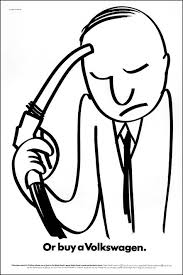The Evolution of the Creative Team
| October 22, 2019 | Posted by Barnaby under Uncategorized |
Comments off
|

Have you seen this print ad? It became famous in the late 1970s when there was an oil embargo and the price of gasoline shot through the roof.
It was created by the legendary creative team of writer Bob Levenson and designer Helmut Krone, working at the advertising agency Doyle Dane Bernbach (DDB) in New York.
DDB turned the advertising world on its head by revolutionizing the way advertising campaigns were created. Bill Bernbach, the agency’s president, had the novel idea of putting a writer and a designer in the same room to come up with campaign ideas from scratch.
Before then, it had been the copywriter’s job to come up with the big idea, write the ad, then hand the copy over to a designer for a layout.
Bernbach’s breakthrough led to many of the most famous and successful campaigns of the 1960s and 1970s. His approach to using two-person creative teams caught on at other agencies and spawned a slew of brilliant ads.
I was fortunate to work in a big New York ad agency when I started my copywriting career that used this approach to generating ideas. My art director partner and I would lock ourselves in a room for hours. My partner would sit with a big magic marker and a drawing pad while I had my yellow pad and we’d kick ideas back and forth. Any idea worth considering would have to be simple enough to sketch on a pad with a single headline.
Sure, most of the ideas sucked. We’d crumple them up and fire them at an empty wastebasket in the corner. A productive day was when we had an overflowing pail of discarded ideas—and a few nuggets worth chasing.
Why did it work so well? It turns out, when at least two people get excited about an idea, it’s likely that 80% of the people who see it will too.
Very often, as freelance copywriters, we spend too much of our time behind our computers, researching and coming up with ideas that get us excited…but fall flat when we show them to other people.
And that’s why today, more and more companies are evolving to use teams of writers and idea generators in new and creative ways.
There are experienced copywriters who work with “copy chiefs” on their projects. These are successful writers with many years of experience who nevertheless hire A-list writers to review and critique their copy to make it even stronger. In return, the copy chief receives an upfront fee and often a percentage of the royalties.
There are peer review groups within some organizations who pitch in to review copy in an organized and systematic way. Using the C.U.B. system invented by Agora (marking up copy sections that are Confusing, Unbelievable or Boring), can make this process work smoothly, especially when you have people who aren’t copywriters yet bring a valuable point of view to the copy.
Then there is the Writer’s Room approach used by comedy shows such as Saturday Night Live or The Daily Show. This is where a bunch of writers (SNL has 27!) get together and pitch their best ideas to the group. It’s a brutal, high-pressure situation but the best ideas rise to the top. Several divisions within the Agora group of companies use this approach to jump-start their promotions.
The bottom line is this: in today’s hypercompetitive and crowded markets, you need extra brainpower to come up with the best ideas and to make them even better in the final presentation. As Bill Bernbach discovered, two heads are better than one. Three heads or more are even better.
What steps are you taking to build your creative teams?






 This is the default footer layout. You can easily add or remove columns in the footer.
This is the default footer layout. You can easily add or remove columns in the footer.
Recent Comments